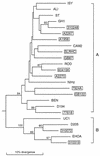Genetically divergent strains of human immunodeficiency virus type 2 use multiple coreceptors for viral entry
- PMID: 9620997
- PMCID: PMC110175
- DOI: 10.1128/JVI.72.7.5425-5432.1998
Genetically divergent strains of human immunodeficiency virus type 2 use multiple coreceptors for viral entry
Abstract
Several members of the seven-transmembrane chemokine receptor family have been shown to serve, with CD4, as coreceptors for entry by human immunodeficiency virus type 1 (HIV-1). While coreceptor usage by HIV-1 primary isolates has been studied by several groups, there is only limited information available concerning coreceptor usage by primary HIV-2 isolates. In this study, we have analyzed coreceptor usage of 15 primary HIV-2 isolates, using lymphocytes from a donor with nonfunctional CCR5 (CCR5 -/-; homozygous 32-bp deletion). Based on the infections of PBMCs, seven of these primary isolates had an absolute requirement for CCR5 expression, whereas the remaining eight exhibited a broader coreceptor usage. All CCR5-requiring isolates were non-syncytium inducing, whereas isolates utilizing multiple coreceptors were syncytium inducing. Blocking experiments using known ligands for chemokine receptors provided indirect evidence for additional coreceptor utilization by primary HIV-2 isolates. Analysis of GHOST4 cell lines expressing various chemokine receptors (CCR1, CCR2b, CCR3, CCR4, CCR5, CXCR4, BONZO, and BOB) further defined specific coreceptor usage of primary HIV-2 isolates. The receptors used included CXCR4, CCR1-5, and the recently described receptors BONZO and BOB. However, the efficiency at which the coreceptors were utilized varied greatly among the various isolates. Analysis of V3 envelope sequences revealed no specific motif that correlated with coreceptor usage. Our data demonstrate that primary HIV-2 isolates are capable of using a broad range of coreceptors for productive infection in vitro. Additionally, our data suggest that expanded coreceptor usage by HIV-2 may correlate with disease progression.
Figures




Similar articles
-
Primary human immunodeficiency virus type 2 (HIV-2) isolates, like HIV-1 isolates, frequently use CCR5 but show promiscuity in coreceptor usage.J Virol. 1999 Mar;73(3):2343-9. doi: 10.1128/JVI.73.3.2343-2349.1999. J Virol. 1999. PMID: 9971817 Free PMC article.
-
Chemokine coreceptor usage by diverse primary isolates of human immunodeficiency virus type 1.J Virol. 1998 Nov;72(11):9307-12. doi: 10.1128/JVI.72.11.9307-9312.1998. J Virol. 1998. PMID: 9765480 Free PMC article.
-
Primary SIVsm isolates use the CCR5 coreceptor from sooty mangabeys naturally infected in west Africa: a comparison of coreceptor usage of primary SIVsm, HIV-2, and SIVmac.Virology. 1998 Jun 20;246(1):113-24. doi: 10.1006/viro.1998.9174. Virology. 1998. PMID: 9656999
-
Chemokine receptors and human immunodeficiency virus infection.Front Biosci. 1998 Jan 1;3:d44-58. doi: 10.2741/a265. Front Biosci. 1998. PMID: 9407151 Review.
-
Genotypic coreceptor analysis.Eur J Med Res. 2007 Oct 15;12(9):453-62. Eur J Med Res. 2007. PMID: 17933727 Review.
Cited by
-
In vitro selection and characterization of human immunodeficiency virus type 2 with decreased susceptibility to lopinavir.Antimicrob Agents Chemother. 2007 Sep;51(9):3075-80. doi: 10.1128/AAC.00146-07. Epub 2007 Jun 18. Antimicrob Agents Chemother. 2007. PMID: 17576848 Free PMC article.
-
Efficient Nef-mediated downmodulation of TCR-CD3 and CD28 is associated with high CD4+ T cell counts in viremic HIV-2 infection.J Virol. 2012 May;86(9):4906-20. doi: 10.1128/JVI.06856-11. Epub 2012 Feb 15. J Virol. 2012. PMID: 22345473 Free PMC article.
-
Cytopathicity of human immunodeficiency virus type 2 (HIV-2) in human lymphoid tissue is coreceptor dependent and comparable to that of HIV-1.J Virol. 2000 Oct;74(20):9594-600. doi: 10.1128/jvi.74.20.9594-9600.2000. J Virol. 2000. PMID: 11000231 Free PMC article.
-
Development of hexadecyloxypropyl tenofovir (CMX157) for treatment of infection caused by wild-type and nucleoside/nucleotide-resistant HIV.Antimicrob Agents Chemother. 2010 Jul;54(7):2901-9. doi: 10.1128/AAC.00068-10. Epub 2010 May 3. Antimicrob Agents Chemother. 2010. PMID: 20439609 Free PMC article.
-
A novel anti-HIV active integrase inhibitor with a favorable in vitro cytochrome P450 and uridine 5'-diphospho-glucuronosyltransferase metabolism profile.Antiviral Res. 2013 Jun;98(3):365-72. doi: 10.1016/j.antiviral.2013.04.005. Epub 2013 Apr 18. Antiviral Res. 2013. PMID: 23602851 Free PMC article.
References
-
- Albert J, Stalhandske P, Marquina S, Karis J, Fouchier R A, Norby E, Chiodi F. Biological phenotype of HIV type 2 isolates correlates with V3 genotype. AIDS Res Hum Retroviruses. 1996;12:821–828. - PubMed
-
- Alkhatib G, Combadiere C, Broder C C, Feng Y, Kennedy P E, Murphy P M, Berger E A. CC CKR5: a RANTES, MIP-1α, and MIP-1β receptor as a fusion cofactor for macrophage-tropic HIV-1. Science. 1996;272:1955–1958. - PubMed
-
- Alkhatib G, Liao F, Berger E A, Farber J M, Pedan K W C. A new SIV co-receptor, STRL33. Nature. 1997;388:238. - PubMed
-
- Andreasson P A, Dias F, Naucler A, Andersson S, Biberfeld G. A prospective study of vertical transmission of HIV-2 in Bissau, Guinea-Bissau. AIDS. 1993;7:989–993. - PubMed
-
- Berger, E. A. 1997. HIV entry and tropism: the chemokine receptor connection. AIDS 11(Suppl. A): S3–S16. - PubMed
Publication types
MeSH terms
Substances
Grants and funding
LinkOut - more resources
Full Text Sources
Other Literature Sources
Research Materials

